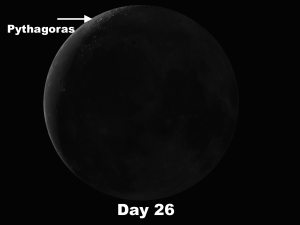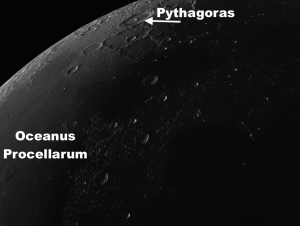The week of April 4 – 10 takes us from lunar Day 26 through Day 4. During most of the week, the Moon will not be in a good position to be observed. On Monday morning, the Moon is just three days from new moon and rises at 4:55 AM. Civil twilight ends at 6:10, so it’s a narrow window with a thin waning crescent. This week we will highlight Pythagoras.
 Pythagoras: [NW/C3] There is only a brief period during each lunation when Pythagoras is visible. It is a complex crater with two central mountain peaks, terraced walls, and internal features. It is an impressive 80 miles in diameter (compare to Copernicus at 58 miles.) Its spectacular rim mountains rise to an imposing three miles above its floor!1
Pythagoras: [NW/C3] There is only a brief period during each lunation when Pythagoras is visible. It is a complex crater with two central mountain peaks, terraced walls, and internal features. It is an impressive 80 miles in diameter (compare to Copernicus at 58 miles.) Its spectacular rim mountains rise to an imposing three miles above its floor!1  The central mountain peaks alone attain a height of one mile. Although it is close to the northwest limb and is substantially foreshortened, it is worth a visit. Try to catch it when the libration is favorable.
The central mountain peaks alone attain a height of one mile. Although it is close to the northwest limb and is substantially foreshortened, it is worth a visit. Try to catch it when the libration is favorable.
OBJECTS OF ADDITIONAL INTEREST THE WEEK OF APRIL 4 – 10:
- If you’re observing the Moon around 5:30 AM, Saturn and Mars will be high in the sky.
- Jupiter is well-positioned for evening observing and transits around 11:00 PM. Jupiter’s moon Io will begin its transit across Jupiter’s face at 3:30 AM EDT, followed by Europa at 4:21 AM. The Great Red Spot will be fully visible at 1:50 AM.
- The Double Cluster in Perseus is visible as soon as it gets dark. It is 7,300 light years away and the brightest stars are 60,000 times brighter than the Sun! This is best viewed with binoculars because you need a wider field of view.
In the year 2000 B.C. there was a solar eclipse in China which had not been predicted by the two court astronomers, Hsi and Ho. Although the country was taken by surprise, everybody knew the drill and the population ran outside and began to yell and scream, blow horns, bang drums, and make an impressive racket (to scare the dragon away that was devouring the Sun.) After a few minutes, to everybody’s great relief, the Sun began to reappear and the kingdom once again averted disaster of the first magnitude–no thanks to Hsi and Ho who were summoned before the emperor and beheaded. Their heads were then grabbed by their long pigtails and flung into the sky where they can be seen to this day as the Double Cluster.
Arcturus shines low over the eastern horizon at 8:30 PM on April 4th. (Find the Big Dipper and follow its “arc to Arcturus.”) It is the fourth brightest star in the heavens and was put to interesting use during the 1933 World’s Fair in Chicago. Shortly before the fair, astronomers had estimated the distance of Arcturus to be 40 light years, and since it had been 40 years since the First World’s Fair in 1893, they hit upon the bright idea of using the light that left Arcturus during the First World’s Fair (which would be arriving just in time) to light up the 40th World’s Fair! At the time, the newly invented photocell, which uses light to generate electricity, was all the rage, so the light that emanated from Arcturus during the First World’s Fair was used. At the appointed hour, light from Arcturus was captured by a telescope at the University of Chicago, which was then directed onto a photo cell, which turned on the lights at the 40th World’s Fair.
Two interesting asides: At a distance of 40 light years, we receive the same amount of heat from Arcturus as we would from a candle placed five miles away! And it is from the mythology associated with Arcturus that the Arctic regions get their name.
1 To put this into perspective, these peaks would soar 7,000 feet higher than Colorado’s 14ers!
======================
It is highly recommended that you get a copy of Sky and Telescope’s Field Map of the Moon, the very finest Moon map available for use at the telescope. It is available for $10.95 at www.skyandtelescope.com and on Amazon. All features mentioned in this blog will be keyed to the grid on the Field Map and will look like this: Plato: [NW/D9]
Credits:
Courtesy of Gray Photography of Corpus Christi, Texas
Lunar photos: NASA / USGS / BMDO / LROC / ASU / DLR / LOLA / Moon Globe. Used by permission
- Rupes Cauchy: A Best Known Fault on the Moon - July 22, 2024
- Moon Crater Schickard – Crater Floor has Stripes - July 15, 2024
- Moon Craters Langrenus and Vandelinus - July 8, 2024